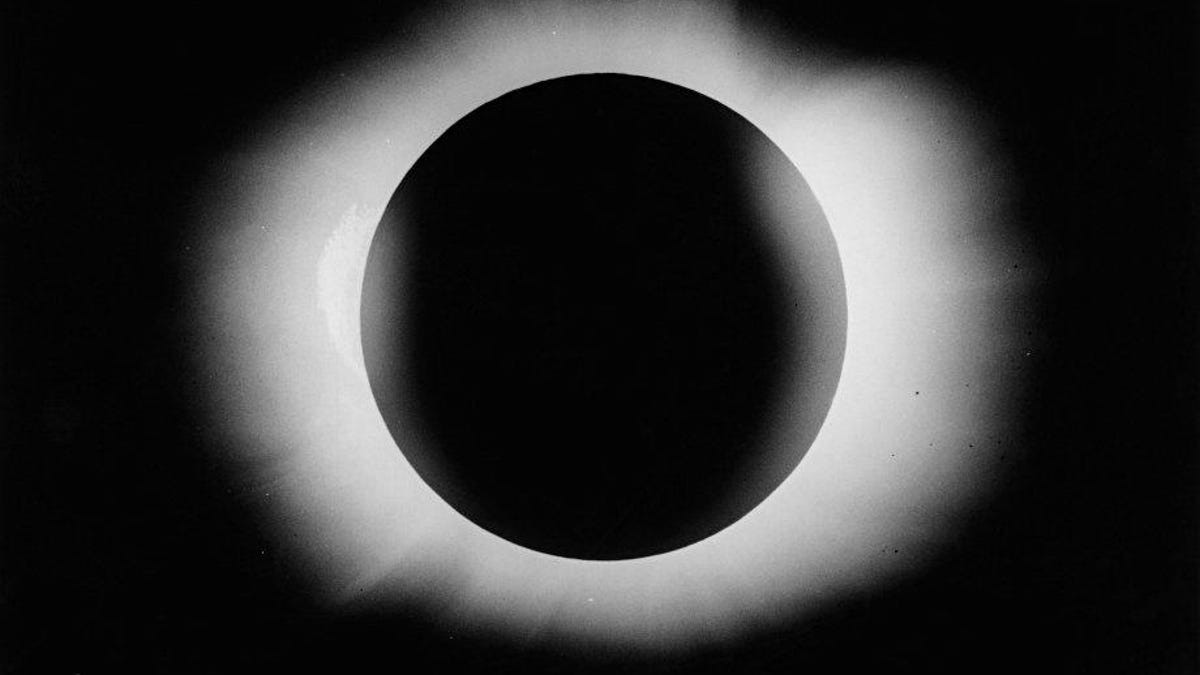100 years ago an eclipse changed history and made Einstein a star
Solar eclipses have been linked to the start of wars and the end of empires, but in 1919 an eclipse revealed the workings of the universe itself.

A century ago, on a small island off the coast of West Africa, a few adventurous astronomers led by Arthur Eddington pointed their telescopes at the sun as it went dark. Their goal was to measure distant stars during what would become one of the most famous total solar eclipses, but in the process they created a whole new kind of star: Albert Einstein.
We owe our understanding of modern physics and astronomy -- and technology like GPS that helps us navigate our daily lives -- to this landmark scientific experiment, which tested Einstein's theory of general relativity 100 years ago.
What was at stake was the scientific equivalent of settling a bet about how the universe works. On one side of the bet was German-born Einstein, and on the other was the British father of modern science, Isaac Newton. At the time, Germany and Britain had just been on opposite ends of bloodiest war either side had ever seen -- World War I.
But rather than geopolitics, the disagreement at hand had to do with gravity and light. According to Newton's conception of physics, light has no mass and therefore cannot be affected by gravity, so it should always move in a straight line. While Einstein's 1915 theory of general relativity does not directly quibble with Newton, it adds the notion that gravity can actually warp the fabric of space-time. He hypothesized that this effect could even be visible with a massive enough object, like the sun, because it possesses enough space-time-warping gravity to make particles of light effectively curve around it.
This means the position of distant stars would actually appear to shift a tiny amount when their light passes near the sun. Of course, it's very difficult to see any stars right next to the sun's bright light, so Eddington set out to test Einstein's theory by observing stars during the eclipse.
As anyone who saw the great American total solar eclipse of 2017 can attest, during the few minutes of totality, stars briefly re-emerge as the shadow of the moon blots out the sun's intense light.
On May 29, 1919, Eddington managed to image a few of the stars nearest the darkened sun. After much calculating, the positions of these stars in the sky, as captured that day from the island of Principe, would show that Einstein's theory passed the test. When the results were announced later that year, it catapulted Einstein to a level of stardom that has persisted to this day.
"A century ago astronomers confirmed the general theory of relativity – in the process transforming our understanding of the Universe for ever," Mike Cruise, president of the Royal Astronomical Society, said in a statement. "The work of Einstein and Eddington is an amazing example of international collaboration in the aftermath of the first world war, and a visible demonstration of how science can overcome barriers in these turbulent times."
It is our understanding of relativity, verified first by the 1919 eclipse experiment, that allows global positioning systems to be accurate down to the centimeter, enabling a wide array of uses from navigation to weather forecasting.
"The observation of this one eclipse by a few astronomers from Britain and Ireland ... may well have been the most important scientific experiment of the entire twentieth century," writes Daniel Kennefick in his book No Shadow of a Doubt: The 1919 Eclipse That Confirmed Einstein's Theory of Relativity.
A half-tone reproduction of one of the images taken of the eclipse.
Over the ensuing decades, other experiments have continued to prove Einstein correct. The discovery of gravitational waves and the recent first-ever direct image of a black hole both served as further evidence that gravity seems to behave as Einstein predicted throughout the universe.
Before the eclipse of 1919, Einstein's ideas were considered too radical and difficult to understand, let alone verify, to be widely accepted. When the results were published some controversy persisted, as cosmologist Peter Coles has written. But with each passing decade relativity seems more clearly to be settled science and the importance of that long-ago eclipse has become clear.
The introduction to the version of the paper published in Science in 1920 might have said it best:
"An eclipse of the sun has become of profound interest also to the physicist, to the mathematician, and to the philosopher, in general."
And in case you're wondering, the next total solar eclipse is just a few weeks away. It will be visible from parts of South America and the South Pacific on July 2.

